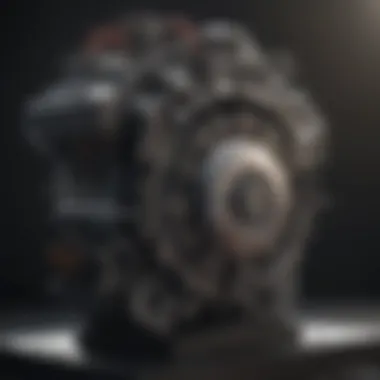Comparing Two-Stroke and Four-Stroke Engines: Insights


Intro
In the vast landscape of engines, two-stroke and four-stroke designs continue to pique the interest of hobbyists and professionals alike. From the thrilling world of extreme sports to everyday machinery, understanding these engines can be the key to maximizing performance and efficiency.
While on the surface, they might seem similar, the mechanics underpinning each are unique, shaping how they operate, their environmental impact, and their suitability for various applications. For thrill-seekers and adventurers, these distinctions can make all the difference when choosing your next piece of equipment or vehicle.
Before diving deeper, it’s important to highlight some key points we will cover:
- Mechanics and Functionality: How each engine works fundamentally.
- Efficiency and Emissions: Comparing fuel consumption and environmental considerations.
- Applications in Extreme Sports: Evaluating the pros and cons of each in extreme situations.
- User Considerations: Tips and insights to guide your decision-making process.
Equipped with this knowledge, enthusiasts can navigate the complexities of engine types with confidence. Whether you are revving up for a motocross adventure or selecting gear for a remote camping trip, comprehension of engine differences plays a crucial role in enhancing experiences.
Preamble to Engine Types
Understanding the mechanics behind two-stroke and four-stroke engines is crucial for anyone enthusiastic about performance and efficiency, especially in the realm of extreme sports. These engines aren't just clunkers that power vehicles—they symbolize a breed of technology that can make or break an adventure. Whether you plan on hitting the trails on a dirt bike or gliding over water on a jet ski, knowing how these engines work and what sets them apart can inform your choices and possibly boost your experiences on the track or in the field.
These differences in engine design impact everything from power output to emission levels, affecting not only performance but also environmental footprint. Taking the time to delve into engine types allows enthusiasts and consumers alike to better judge which option aligns with their specific needs. The significance of this discussion extends beyond mere mechanics; it taps into safety, the long-term viability of one's gear, and even the pleasure derived from using well-suited equipment.
Overview of Engine Mechanics
To grasp the essence of two-stroke and four-stroke engines, one must first recognize how they function fundamentally.
- Two-Stroke Engines: These engines complete a power cycle in just two strokes of the piston—hence the name. They achieve this by combining the intake, compression, power, and exhaust strokes into two movements. This design allows for higher power output in a smaller frame, making it a favorite for lightweight applications. However, this efficiency often comes at the cost of increased emissions and a higher rate of consumption of lubricants.
- Four-Stroke Engines: In stark contrast, four-stroke engines require four strokes of the piston to complete a power cycle. This translates to a greater degree of efficiency and typically less wear and tear, providing a smoother operation. However, the added complexity of the system can sometimes lead to more significant maintenance needs and potential weight issues. The better fuel efficiency gained is often one of its standout benefits, appealing to longer treks or journeys.
In sum, each type of engine has its nuances. While the two-stroke engine might push you faster down a dirt path, the four-stroke engine might let you travel further with fewer stops. Understanding these distinctions is foundational to making informed decisions that could impact your sport, hobbies, or simply your daily driving needs.
The balance between performance and efficiency often determines whether one engine type selks better than the other for specific applications.
Fundamental Principles of Two-Stroke Engines
The significance of understanding the fundamental principles of two-stroke engines cannot be overstated, especially for those who revel in the thrill of extreme sports. These engines operate on a simpler design and have distinct benefits that set them apart from their four-stroke counterparts. By grasping how two-stroke engines work, users can make informed decisions about the machines they choose for their adventures.
Basic Operation of Two-Stroke Engines
At its core, a two-stroke engine completes a power cycle in just two strokes of the piston, or one crankshaft revolution. This means that for every single turn of the crankshaft, the engine produces one power stroke. The simplicity of this mechanism leads to a lightweight design, which many thrill-seekers prefer. Generally, two-stroke engines rely on a mixture of oil and fuel for lubrication, feeding right into the combustion chamber.
The process involves two main strokes: the compression stroke and the power stroke. During the upstroke, the piston compresses the air-fuel mixture, creating pressure. As the piston reaches the top, the spark plug ignites the compressed mixture, forcing the piston downward in a powerful thrust. An essential characteristic of this type of engine is the simultaneous intake and exhaust of the gases, which helps it operate more effectively in demanding environments.
Power Stroke Efficiency
Power efficiency is a hallmark of two-stroke engines, as they can generate power with every rotation. This means that they often deliver more power for their size compared to four-stroke engines. The lightweight nature and high power-to-weight ratio are critical elements for applications in off-road vehicles and motorcycles. In these contexts, the demand for quick acceleration cannot be overemphasized, and two-stroke engines meet those needs with gusto.
However, it's worth noting that while these engines can be more powerful, they can also be less efficient in terms of fuel consumption. This makes them a double-edged sword; you get raw power but may pay for it at the pump. When it comes to high-speed chases through rugged terrains or racing on a dirt track, that higher power output can often be worth the trade.
Lubrication and Environmental Impact
Lubrication in two-stroke engines is often done through the fuel mixture, which keeps moving parts well-oiled. However, this method of lubrication can lead to increased emissions since some unburned oil is expelled with exhaust gases. This brings us to the environmental considerations. The emissions profile of two-stroke engines tends to be worse than that of their four-stroke rivals, making them less favorable in terms of ecological impact.
Depending on the fuel used, two-stroke engines can spew out more hydrocarbons into the atmosphere. As regulations around emissions become stricter, many users are finding it necessary to consider these factors. It's not just about performance; it’s about what you’re contributing to the world around you. With all said, while two-stroke engines are championed for their power and simplicity, the environmental implications shouldn't be brushed aside.
"People love the raw thrill a two-stroke engine can provide, but it comes with responsibilities and considerations that every user must reflect on."
In sum, embracing the principles behind two-stroke engines not only leads to better performance decisions but also fosters a better appreciation of the environmental context within which these machines operate. As adventure lovers gear up for their next big outing, being aware of these mechanics can make a significant difference in choosing the right equipment.
Fundamental Principles of Four-Stroke Engines
Understanding the fundamental principles of four-stroke engines is critical in identifying their unique features, advantages, and specific operational characteristics. While two-stroke engines have garnered attention for their simplicity and high power output, four-stroke engines provide a nuanced performance and efficiency profile that is often more suited for various applications, especially in extreme sports and high-performance vehicles. The elaborate mechanical cycle, consisting of intake, compression, power, and exhaust strokes, contributes to superior fuel efficiency, reduced emissions, and enhanced longevity compared to their two-stroke counterparts.
Basic Operation of Four-Stroke Engines
In a four-stroke engine, the term "four-stroke" refers to the four distinct actions that occur during one complete cycle of operation. These strokes include:
- Intake Stroke: The first step draws a mixture of air and fuel into the cylinder when the intake valve opens and the piston moves down.
- Compression Stroke: Next, the piston moves back up, compressing the air-fuel mixture, which increases its temperature and pressure, making it more volatile.
- Power Stroke: Once compression reaches its peak, a spark plug ignites the mixture, causing a rapid expansion of gases that pushes the piston down, generating power.
- Exhaust Stroke: Finally, the piston moves back up again, pushing out the spent gases through the open exhaust valve.
This systematic operation allows four-stroke engines to run more efficiently since every cycle produces one power stroke, minimizing fuel wastage and promoting smoother performance. The mechanical layout commonly found in vehicles powered by these engines is more complex yet highly effective, leveraging carefully timed valve operations and piston movements.
Fuel Efficiency and Performance
Four-stroke engines are often lauded for their fuel efficiency, generally better than that of two-stroke engines. The way these engines manage fuel intake and combustion leads to more complete burning of the fuel, which translates to less fuel consumed per power stroke. Some particular benefits include:
- Less Fuel Wastage: The design minimizes fuel leakage between strokes, ensuring that almost every drop of fuel contributes to energy production.
- Smoother Power Delivery: The staged mechanism of four-stroke cycles provides steadier power output, which enhances vehicle handling and performance, especially in high-demand activities like off-road biking or motocross.


Moreover, modern engineering innovations, such as variable valve timing and advanced fuel injection, contribute to even greater efficiency and performance under varying conditions. This makes four-stroke engines a preferred choice for enthusiasts who require reliability and balance in their rides.
Emissions and Lubrication Considerations
Environmental concerns can not be overlooked when discussing engine types, and four-stroke engines generally produce fewer emissions compared to two-stroke designs. The reason? The separate lubrication system in four-stroke engines limits unburned oil from entering the combustion chamber, a common issue in two-stroke engines. This not only improves the ecological footprint but also helps in:
- Regulation Compliance: Many regions impose strict emission standards; four-stroke engines can more reliably meet these regulations, making them a better choice for sporting applications in many areas.
- Extended Engine Life: With dedicated lubrication, the frictional wear on engine components is reduced, leading to lower maintenance needs and prolonged engine lifespan.
In summary, the operating principles of four-stroke engines elucidate a design that prioritizes efficiency, power, and cleaner emissions, making it an appealing option for serious riders. These engines embody an intricate balance of engineering brilliance and practical application that resonates with thrill-seekers and adventure lovers alike.
"In essence, four-stroke engines represent a marriage of efficiency and performance, designed to cater to the demands of both the environment and the enthusiast."
By grasping these foundational concepts, enthusiasts are better equipped to navigate the complexities of engine choices and select vehicles that align with their adventure-seeking spirit.
Comparative Analysis of Performance
When it comes to understanding the differences between two-stroke and four-stroke engines, performance serves as a critical battlefield for comparison. This section delves deep into the ways in which these engines differ regarding torque, power output, acceleration, and throttle response. Each facet of performance can significantly affect the riding experience, particularly for those who thrive on adventure and adrenaline.
Torque and Power Output
Torque and power output are fundamental elements that define how an engine performs under various conditions. Two-stroke engines, due to their simpler operating mechanism, often produce power with regularity. They complete a power cycle in just two strokes of the piston, thus generating power with every crankshaft revolution. This results in a power delivery that is immediate and punchy, which can be ideal for off-road situations or quick maneuvers where immediate throttle response matters.
On the flip side, four-stroke engines undergo a more complex cycle, completing their power stroke only once every four strokes. This leads to a distribution of power that may feel more linear but can sometimes lack the explosive characteristics favored in extreme sports. Four-stroke engines typically generate higher peak torque at higher RPMs, making them more suited for sustained power over long distances or varied terrains.
"Power isn't just about how much an engine can churn out; it’s also about how effectively that power meets the demands of the surface beneath your tires."
Acceleration and Throttle Response
Acceleration and throttle response are two sides of the same coin when discussing engine performance. Two-stroke engines tend to excel in quick acceleration, thanks to their power and weight ratios. They respond immediately to throttle inputs, making them a favorite for racers and adventure enthusiasts seeking thrilling acceleration. This characteristic can often come in handy during an unexpected shift in terrain or urgent need for speed.
On the other end, four-stroke engines may appear to lag in terms of responsiveness initially. However, they offer a more controlled acceleration which is crucial for longer trails and open roads. Their engineered sophistication allows for better power modulation, resulting in smoother transitions that can be more comfortable for riders over extended periods. This aspect of four-stroke engines may also contribute to a more enjoyable ride when navigating through varied terrain types where control is key.
In sum, while two-stroke engines tend to excel at raw power and quick accelerations, four-stroke engines provide nuanced power delivery that caters to longer journeys and rough landscapes. The choice between them ultimately rests on the rider's preference, style of use, and the specific demands of their adventurous pursuits.
Durability and Maintenance Requirements
The durability and maintenance requirements of two-stroke and four-stroke engines are crucial aspects that significantly affect not just performance but also ownership experience. Understanding these factors helps enthusiasts make better decisions regarding their equipment, ultimately leading to more enjoyable and trouble-free adventures. A rugged outdoor lifestyle places demands on machinery that goes beyond ordinary use; thus, the longevity of engines must be considered alongside their operational efficiencies.
Maintenance Frequency Insights
Maintenance frequency can influence an engine's reliability and functionality. Two-stroke engines are often simpler in design, leading to less rigorous maintenance schedules. However, they also have a reputation for needing oil mixed with fuel, which turns maintenance into a more frequent chore. Users may find themselves regularly checking mixing ratios and oil quality to ensure optimal performance.
In contrast, four-stroke engines typically require less frequent oil changes due to their separate oil systems, which can translate into extended intervals between servicing. The complexity of their inner workings requires attentive upkeep; neglect could result in higher stakes repairs.
- For two-stroke engines, users might follow a schedule such as:
- For four-stroke engines, a more leisurely maintenance timeline could include:
- Daily checks before hitting the road or trail.
- Regular lubrication of components every few rides.
- Fuel mixture checks with each tank fill-up.
- Oil change every 3,000 to 5,000 kilometers, depending on the manufacturer.
- Routine checks every few weeks to ensure all aspects are functioning well.
- Timing belt inspections according to the manufacturer's guidelines.
Getting into a rhythm with maintenance routines is a must; a stitch in time saves nine rings true when it comes to engines. Consistency pays off well in the long run, keeping both your engine and your heart in top shape.
Longevity and Engine Wear
Longevity hinges on many variables, including material quality, engine design, and the usage habits of the owner. Generally, four-stroke engines tend to have a favorable edge due to their operating cycle that allows for better lubrication and lower operating temperatures. Under normal conditions, these engines can clock considerable hours with fewer signs of wear. Engine wear is often categorized by components like cylinders, piston rings, and valve seats, and with proper upkeep, a four-stroke engine may last significantly longer before requiring major overhauls.
On the other hand, two-stroke engines, albeit offering thrilling performance, can face faster degradation due to their high-revving nature and reliance on mixed fuel. The wear and tear on components is often more rapid, emphasizing the need for regular inspections.
"Proper maintenance creates a safety net against unexpected breakdowns and escalated repair costs."
It's essential for the owner to keep an eye on these factors:
- For two-stroke engines:
- For four-stroke engines:
- High RPM operation leads to more gradual wear; monitor closely.
- Components requiring regular inspection: piston rings and exhaust ports.
- Requires systematic checks on oil levels and quality.
- Components to monitor: camshaft, valves, and timing chains.
In the grand scheme, enthusiasts must weigh these elements carefully. While the two-stroke engine may excite with its quick responsiveness, the longevity and ease of maintenance of a four-stroke engine can serve some rather than the fleeting thrill of speed alone. Whatever the choice, knowledge about durability and maintenance equips the rider to tackle any challenges head-on.
Applications in Extreme Sports
Extreme sports push the boundaries of human capability and machine engineering, demanding performance that few vehicles can deliver. In this realm, the choice between two-stroke and four-stroke engines becomes a critical factor, influencing everything from speed to maneuverability. Understanding how each engine type excels or falls short in extreme conditions is vital for adventure seekers and thrill enthusiasts.


Motorcycles and Off-Road Bikes
Motorcycles, especially those designed for off-road adventures, heavily rely on the unique characteristics of both two-stroke and four-stroke engines. Here's why this distinction matters:
- Power and Weight: Two-stroke engines are often lighter and provide a higher power-to-weight ratio. This translates to quicker acceleration and better handling on rough terrains. Riders can often feel a sense of exhilarating response when twisting the throttle.
- Maintenance Ease: Given their simpler mechanics, two-stroke engines generally require less maintenance, making them a popular choice for motocross bikes where performance and speed are paramount.
- Torque Characteristics: Four-stroke engines, while heavier, produce more torque at lower RPMs. This strength is particularly beneficial for technical uphill climbs and navigating obstacles, giving riders confidence that they can tackle challenging trails without stalling.
The choice often boils down to personal preference, with some riders swearing by the zippy agility of a two-stroke, while others rely on the robust power of four-strokes.
Watercraft Utilization
In the realm of water sports, the engine type also plays a significant role in enhancing performance. Whether it's jet skis or performance boats, understanding the applications can significantly impact the experience:
- Acceleration Response: Two-stroke engines deliver quicker power bursts, which are ideal for activities like racing or high-speed maneuvers. Riders can zip across waves with an agility that is unmatched, allowing for thrilling jumps and sharp turns.
- Fuel Efficiency Considerations: Four-stroke engines, with their refined fuel systems, often provide better fuel economy at sustained speeds—ideal for leisurely cruises or long-distance racing.
- Weight and Balance: Two-stroke engines keep watercraft lightweight, enhancing fluidity during sharp turns or in choppy conditions. However, four-stroke engines balance the weight, promising controlled and stable rides, particularly when carrying passengers or gear.
"Choosing the right engine for your watercraft can make or break your experience on the water. The speed and agility of a two-stroke might thrill you, but the steady power of a four-stroke offers reliability and efficiency."
Ultimately, extreme sports enthusiasts must weigh the pros and cons, considering their individual riding styles, the terrain, and their specific performance needs. Each engine type has distinct virtues that can complement various extreme sports activities, necessitating informed choices for success and satisfaction in the field.
Fuel Types and Energy Density
When it comes to engine performance, the type of fuel used plays a critical role. This section dives into various fuels and their respective energy densities, clarifying how these elements influence the functionality and overall efficiency of two-stroke versus four-stroke engines. Understanding fuel characteristics allows buyers to make knowledgeable choices, especially when gearing up for extreme sports activities.
Conventional Fuels Vs. Alternatives
Conventional fuels, primarily gasoline and diesel, have dominated the market for years. For two-stroke engines, a common fuel is mixed gasoline — typically a blend of regular gasoline and specific oil to provide needed lubrication during operation. On the other hand, four-stroke engines often run on pure gasoline, which minimizes oil contamination and aids in cleaner burn.
However, the landscape is changing as alternative fuels gain traction. Ethanol blends, biodiesel, and even hydrogen are becoming more appealing options. While these alternatives can offer environmental benefits, they also carry unique considerations. For instance:
- Ethanol can lead to increased efficiency due to its high octane rating, though it requires adjustments in the engine for optimal performance.
- Biodiesel provides advantages in terms of biodegradability, yet it can foster fuel line issues in older engines due to its solvent properties.
- Hydrogen, although not widely adopted, presents the potential for zero emissions, though significant infrastructure hurdles exist.
In the context of extreme sports, the choice of fuel impacts more than just performance metrics; it can also affect the engine's response times and overall ride quality. For racers or thrill-seekers who prioritize speed and power, understanding the trade-offs between these various fuels can be pivotal to ensuring peak performance.
Impact on Performance and Longevity
The energy density of fuel, which refers to the amount of energy stored in a given volume, ultimately determines how effectively it can be converted into power. Fuels with higher energy density, like conventional gasoline, typically yield better performance outcomes in both two-stroke and four-stroke engines, but they also come with drawbacks pertaining to longevity and engine wear.
For instance:
- Higher energy fuels can provide thrilling acceleration and improved throttle response, making them suitable for high-demand activities. However, they may cause increased wear on engine parts due to the heat produced during combustion.
- Alternative fuels, while sometimes offering lower energy density, promote cleaner burning, which could extend the life of engine components that typically suffer from deposits and corrosion.
In essence, the right fuel choice may correlate directly with not only immediate performance metrics but also long-term durability of the engine. For enthusiasts in extreme sports, achieving a balance between these considerations is essential for an optimal experience on the track or trail.
"Choosing the right fuel is not just about power; it's also about preserving the integrity of the engine for the adventures ahead."
As you gear up for your next outdoor thrill, keep these fuel considerations in mind. The right choice not only props up performance but may also be key to longevity and reliability throughout a series of heart-pounding rides.
Environmental Considerations
When discussing two-stroke and four-stroke engines, the environmental impact weighs heavily on the conversation. Understanding how these engines affect our surroundings is crucial, especially in an era where eco-friendliness is becoming paramount. It’s not just about performance or efficiency; it’s about the bigger picture – how our choices impact the planet.
Emission Profiles of Two-Stroke Engines
Two-stroke engines, while often lauded for their power-to-weight ratio, carry a reputation for higher emissions compared to their four-stroke counterparts. The reason for this lies in their operational design. In a two-stroke engine, every rotation of the crankshaft results in a power stroke. However, this efficiency comes with a caveat – unburnt fuel can escape into the atmosphere during the intake and exhaust process. As a result, two-stroke engines generally produce more pollutants, including hydrocarbons and particulate matter.
The emissions from these engines can wreak havoc not just on air quality but also on the health of those operating them. Research has shown that exposure to these pollutants can lead to respiratory issues, making it paramount for users to consider the potential health implications.
"Understanding emissions is not just about stats; it’s about our health and the future of our planet."
Regulatory Impacts on Engine Design
In response to the growing environmental concerns, regulatory bodies have started to take a closer look at engine designs. Stricter emission standards have prompted manufacturers to innovate, particularly in the two-stroke market. Brands have begun integrating technologies such as direct fuel injection systems and improved combustion techniques to reduce harmful emissions.
These developments signal a shift in how two-stroke engines are perceived. No longer just seen as gas guzzlers, advancements are making them cleaner. Yet, the pressure to adapt isn’t solely upon manufacturers. Users and enthusiasts should also be aware of the regulations applicable in their regions, which may dictate what types of engines can be used in certain environments.
- Maximum Emissions Limits: Regulatory bodies have set clear guidelines on the maximum allowable emissions for various engine types.
- Encouragement of Research: Regulations are pushing for a push in innovation and research in cleaner engine options.
- Incentives for Cleaner Technologies: Many regions now offer grants or subsidies for engines that meet specific eco-friendly criteria.
Overall, while two-stroke engines may have faced scrutiny for their environmental footprints, advancements in technology and legal frameworks are driving the conversation toward a greener future.
Economic Implications
Understanding the economic implications of two-stroke and four-stroke engines is key for anyone looking to invest in or use these powerhouses. It's not just about the cost upfront, but what maintaining and reselling these engines might cost you in the long run. This section will look into various factors including purchasing price, operating costs, and resale potential, giving you a clearer picture of what you might be signing up for.
Cost of Ownership: A Breakdown


When considering the cost of ownership, enthusiasts need to factor in multiple components that contribute to the overall investment. It’s not all black and white; several aspects come into play:
- Purchase Price: Two-stroke engines generally have a lower initial cost. They are simpler, less complicated in terms of engineering, and cheaper to manufacture. Meanwhile, four-stroke engines, being more elaborate with numerous components, often price higher at the dealership.
- Fuel Consumption: Two-stroke engines tend to consume more fuel since they mix oil and fuel together. This might seem acceptable at first, but over time, this adds up and can outstrip the savings from the initial lower purchase price.
- Maintenance Costs: Regular maintenance is an inevitable part of engine ownership. For two-stroke engines, maintenance tends to be simpler and less costly due to fewer internal parts. However, they may require more frequent oil changes due to their lubrication needs. In contrast, four-stroke engines can be pricier to maintain due to the complexity and the higher cost of parts, but they typically require less frequent maintenance.
- Depreciation: The resale value is another aspect of cost to consider. Most folks can expect faster depreciation on two-stroke engines. They tend to lose value quickly; however, this can be mitigated depending on the market and the engine’s condition at the time of sale. On the other hand, four-stroke engines manage to retain more of their value, especially if well-kept.
"An engine purchase isn’t just an owner’s decision; it’s an investment choice that can impact budget long after the transaction has closed."
In summary, while two-stroke engines may be cheaper at the outset, their operational costs and depreciation patterns can lead to a higher total cost of ownership in the long haul. Four-stroke engines may require a larger investment upfront but can prove more economical over time by maintaining better resale value and requiring less frequent servicing.
Resale Value and Market Perception
When it comes down to selling, understanding market perception is crucial. The resale value of engines can fluctuate significantly based on brand, model, condition, and, importantly, the type of engine. Let’s take a closer look:
- Brand Reputation: Brands like Honda or Yamaha tend to maintain strong market perception due to their history, reliability, and customer loyalty. For four-strokes, this factor often comes into play more affectively.
- Engine Reliability: Generally, two-stroke engines are perceived to be less durable in the long run, which can adversely affect their resale value. Buyers are often hesitant, believing these engines might require significant repairs shortly after purchase.
- Niche Market: Some two-stroke models have carved their own niche within certain communities, especially among vintage enthusiasts or off-road bikers. For these models, resale value may be unexpectedly high, depending on demand.
- Four-Stroke Popularity: The four-stroke engine market is generally viewed as more desirable for its efficiency and longevity. Buyers are often willing to pay a premium for a well-maintained four-stroke engine since they have established a reputation for reliability.
- Market Trends: Keep an eye on market trends—sometimes economic shifts can make certain engines more desirable, often affecting resale value. As regulations tighten around emissions, four-stroke engines might find a more favorable market due to their generally lower emissions.
User Experience and Ergonomics
When diving into the realm of two-stroke and four-stroke engines, there's a piece that often croses the mind of thrill-seekers and extreme sports enthusiasts – user experience and ergonomics. These factors are not just afterthoughts; they are core elements that can significantly influence how riders interact with their machines.
A well-designed engine can enhance the overall experience for the user, making it intuitive and enjoyable. If an engine is awkward or difficult to manage, it can quickly sour the thrill of the ride.
Handling and Ride Quality
Handling refers to how well a bike or any motorized vehicle responds to the rider’s inputs, while ride quality encompasses the overall comfort one experiences during the ride. For riders who tackle rugged terrains, these aspects matter immensely.
Two-stroke engines, by nature, have a lighter build. This makes them more nimble, ideal for quick maneuvers in off-road situations. Riders often find that they can flick a two-stroke bike with ease, almost like handling a feather. The quicker power delivery can leave riders with a sense of connectedness to the engine that some enthusiasts find addictive.
On the other hand, four-stroke engines bring a different flavor to the handling game. Although they might be heavier and less maneuverable due to their complexity and additional components, they excel in providing stability at higher speeds. Many riders appreciate the smooth transitions and control, particularly on long-distance rides where comfort becomes paramount. The handling might not be as lively as a two-stroke, but the predictability can heighten confidence, especially for those pushing their boundaries on challenging tracks.
User sentiment often echoes this divide:
- Riders of two-stroke engines frequently praise the thrill of responsiveness and agility.
- Conversely, four-stroke riders highlight the comfort and stability, particularly when facing long stretches of varied terrain.
User Preferences and Feedback
User preferences can provide valuable insights into choosing between two-stroke and four-stroke engines. Feedback from the riding community can act as a crystal ball, revealing significant trends in what riders seek based on their personal riding experiences.
From online forums like Reddit, discussions abound surrounding the merits and drawbacks of each engine type. Riders often share practical advice based on their own exploits. For instance, a user might mention how the unpredictable power band of a two-stroke can be thrilling but can also lead to a less stable ride unless the rider is skilled. Similarly, four-stroke engine users may find joy in their engine's reliability, especially vital when embarking on long excursions where breakdowns can ruin the adventure.
Additionally, ergonomic design features play a crucial role. The layout of controls and comfort of seating can dictate how long a rider can enjoy their experience. A bike that feels like an extension of the rider’s body is colossal on the experience scale. Here are a few factors that riders often discuss in their feedback:
- Handlebar Position: Compatibility with rider height and comfort preferences.
- Seat Comfort: Longer rides require supportive seating that doesn't lead to fatigue.
- Control Accessibility: Ease of reaching throttle, brakes, and gear shifts can make or break the experience.
In essence, while the technical specifications of two-stroke and four-stroke engines lay the groundwork, it’s the subtle nuances of user experience and ergonomics that can truly awaken the passion for extreme sports. Thus, potential buyers need to consider how each engine's characteristics align with their personal preferences and riding style.
Future Development Trends
In the ever-evolving field of engines, particularly when comparing two-stroke and four-stroke designs, it becomes vital to examine future development trends. This topic not only encapsulates ongoing innovations but plays an essential role in shaping the direction of engine technology and its interaction with different markets. Considering advancements in performance efficiency, emissions reductions, and user adaptability is crucial for anyone involved in extreme sports or outdoor adventures.
Innovations in Engine Technology
As engineers and designers delve deeper into improving engine functionality, several noteworthy innovations have surfaced:
- Turbocharging and Supercharging: These methods enhance power output while maintaining efficiency, allowing even small-capacity engines to deliver impressive performance levels.
- Variable Valve Timing: This technology optimizes the timing of valve openings based on the engine's speed and load, thereby efficiently balancing power delivery and fuel efficiency.
- Advanced Fuel Injection Systems: Unlike traditional carburetors, modern fuel injection provides better precision, leading to improved fuel economy and reduced emissions. Systems like direct injection are gaining traction for their enhanced performance.
These innovations steer the discussion toward how they impact user experience and machine capability, especially in high-performance contexts such as competitive motorsports or rugged outdoor activities. Engine manufacturers now prioritize lightweight designs that don't sacrifice robustness, thus appealing to thrill-seekers and adventure lovers alike.
The Influence of Electrification
The encroachment of electric vehicles into the market has initiated a tidal wave of change. Though one could argue that some electrification features hardly mix with traditional engine types, their influence cannot be overlooked. Here’s how electrification reshapes engine dynamics:
- Hybrid Systems: Incorporating electric motors alongside two-stroke or four-stroke engines yields a treasure trove of efficiency. This fusion not only boosts power but also allows for smoother acceleration, ideal for off-road enthusiasts who value both muscle and finesse in their rides.
- Regenerative Braking: This technology recovers energy lost during braking, feeding it back into the system. It’s especially advantageous for vehicles operating in environments that demand frequent stopping and starting, lending itself to trails and tracks.
- Battery Technology: With advancements in battery storage capacity and longevity, hybrid systems with both gas and electric capabilities are being engineered to last longer and offer better performance.
"Engine technology is not just about combusting fuel anymore; it’s about harnessing everything at our disposal to optimize performance, sustainability, and the thrill of the ride."
The End
In wrapping up our deep dive into the world of two-stroke and four-stroke engines, it becomes clear that understanding these two types of powerhouses is vital for anyone with a vested interest in the realm of motorsports, adventure-laden pursuits, or simply the mechanics of engines. Their distinctive operational principles shape not only performance but also emissions, efficiency, and maintenance demands.
One significant element worth considering is the type of application one plans to undertake. Two-stroke engines, known for their enhanced power-to-weight ratio, provide that adrenaline rush for thrill-seekers. They excel in environments where weight and quick responsiveness matter, making them a popular choice for motocross and some watercraft. Conversely, four-stroke engines, boasting greater fuel efficiency and longevity, cater more to those who seek durability and lower emissions – ideal for recreational rides or longer journeys.
Furthermore, the environmental implications each engine type brings to the table cannot be brushed aside. While two-stroke engines have made advancements in reducing pollution levels, the four-stroke counterparts generally offer a cleaner operation from the outset. This aspect aligns with the growing trend of eco-conscious recreational choices.
Thus, this conclusion isn’t just about engines; it's about making informed decisions that resonate with our desires for performance, environmental responsibility, and the sheer joy of adventure. The analysis provided here serves as a compass, guiding enthusiasts towards what fits their needs best.
Key Takeaways
- Application Matters: Two-stroke engines are lightweight and responsive; four-stroke engines focus on durability and fuel efficiency.
- Environmental Impact: Two-stroke engines tend to have more emissions ongoing, while four-stroke engines generally operate cleaner.
- Maintenance Requirements: Two-stroke engines require more frequent upkeep; four-stroke engines offer longevity with proper care.
- Performance Preferences: Choosing the right engine depends on the thrill factor versus the need for reliability in various sports and recreation.
Understanding these aspects can profoundly influence your choices in selecting the right equipment for outdoor adventures. Whether you lean towards speed or sustainability, being knowledgeable empowers you to enhance your experiences.







